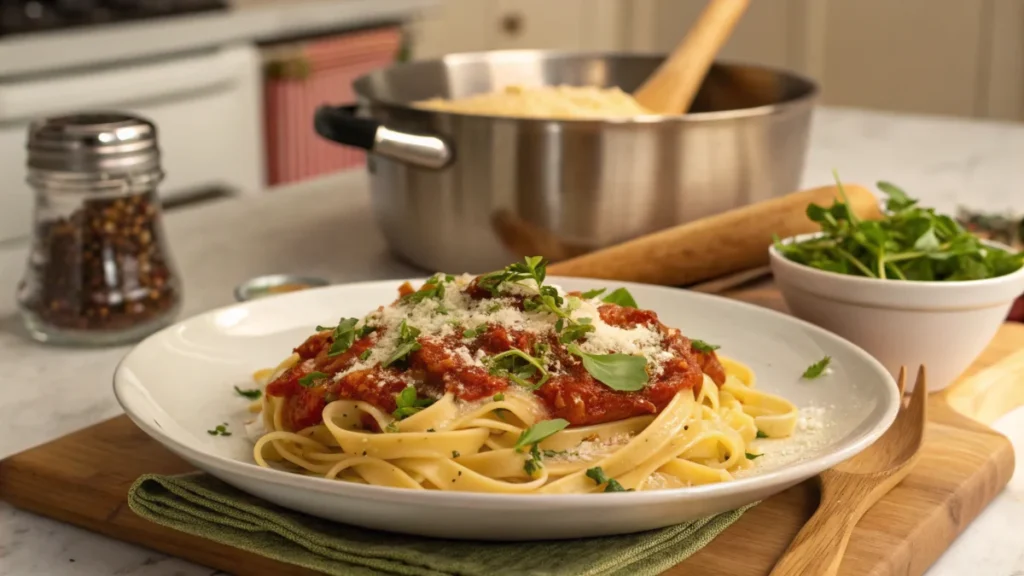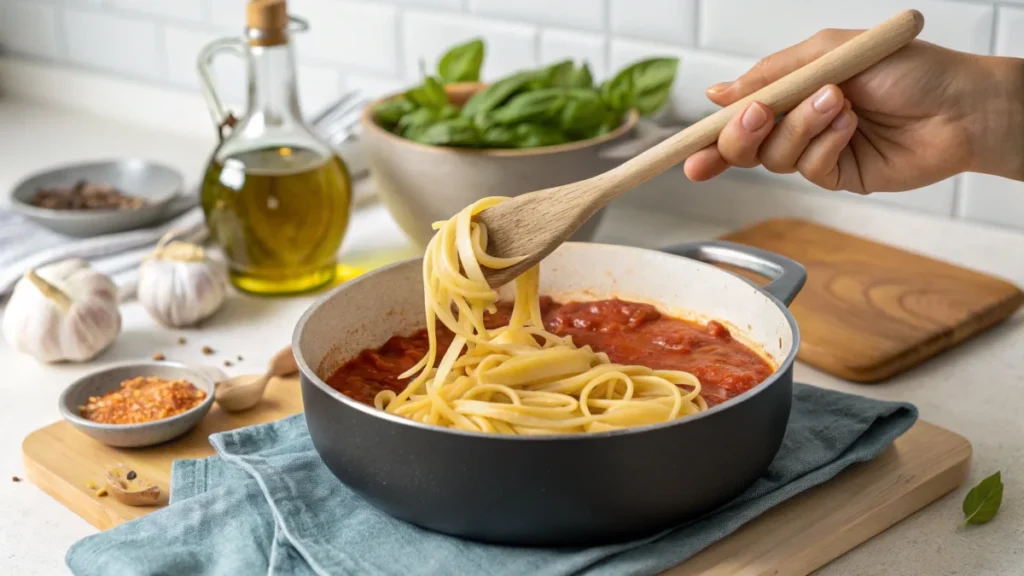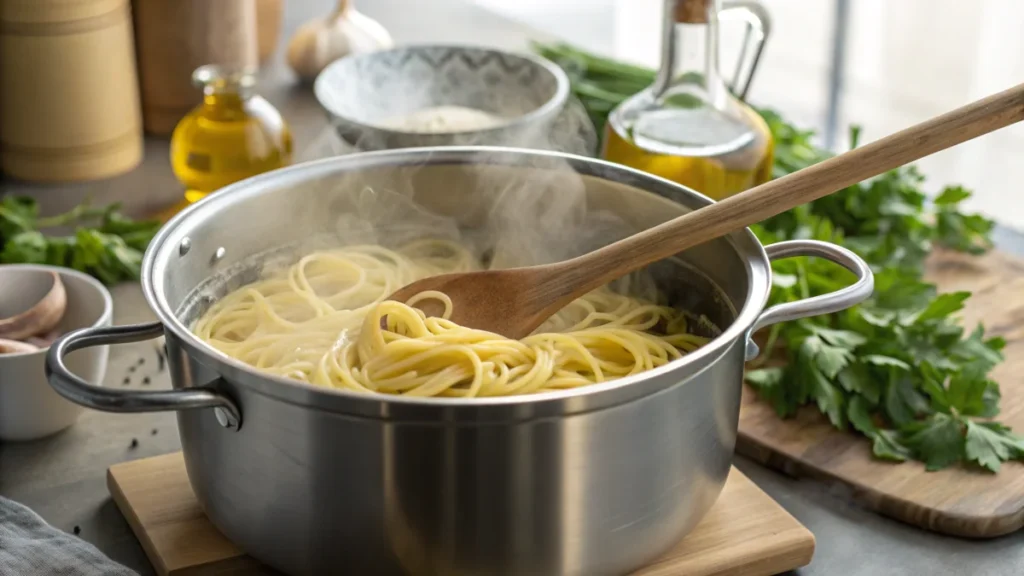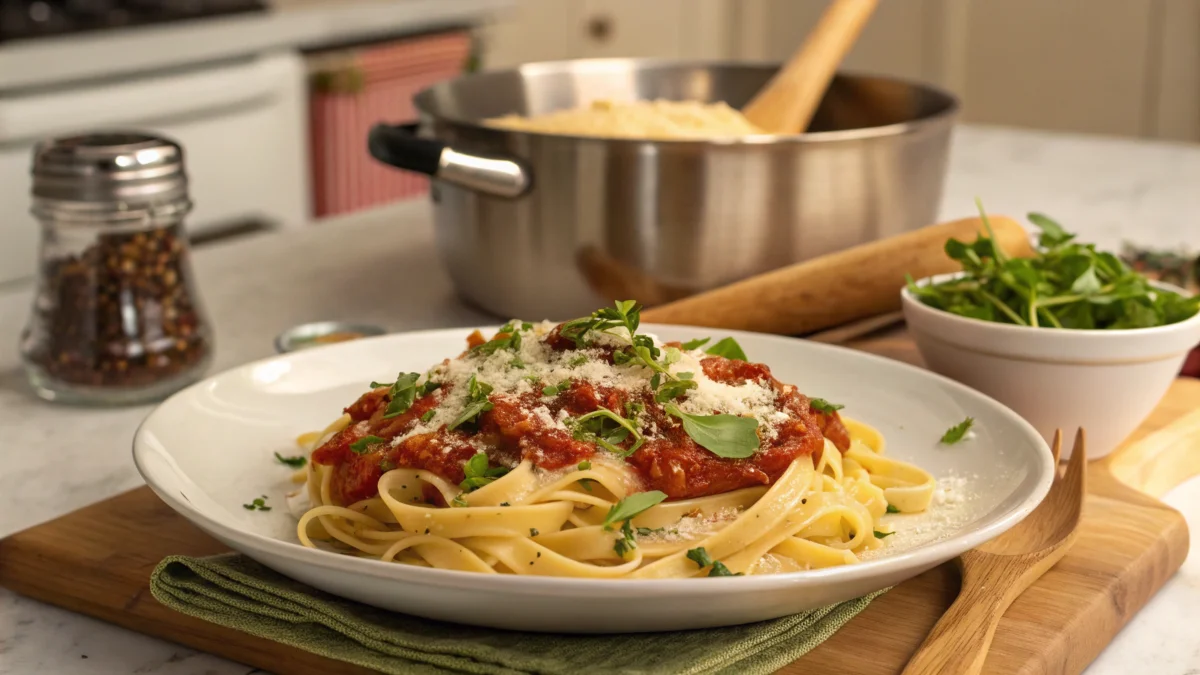How to Cook Pasta perfectly is an art that requires the right technique, precise timing, and a bit of culinary intuition. Whether you’re preparing a quick weeknight dinner or an elaborate gourmet meal, mastering how to cook pasta can elevate any dish. It’s not just about boiling water—selecting the right type of pasta, using the correct water-to-pasta ratio, and knowing when it’s al dente are all key steps. Pairing pasta with the right sauces, herbs, and garnishes also makes a big difference. This guide will walk you through each essential step, ensuring you create delicious, flavorful pasta dishes every time. With these tips, you’ll gain the confidence to cook pasta like a pro.
If you’re looking for more inspiration and new ways to enjoy pasta, be sure to check out our article on the Best Pasta Dish in the World. Explore the favorite, most eaten, and even the rarest pasta recipes from around the globe, and discover how diverse and exciting pasta can be in various culinary traditions.

Table of Contents
Choosing the Right Pasta
The first step in cooking pasta is selecting the right type for your dish. While pasta might seem like a one-size-fits-all food, different shapes and sizes are better suited for different types of sauces and meals. Therefore, it’s essential to choose the right pasta shape that complements your sauce.
- Spaghetti: Best paired with simple sauces like marinara or aglio e olio.
- Fettuccine: Ideal for creamy, heavy sauces like Alfredo or carbonara.
- Penne: Works well with chunky sauces, like Bolognese, as the shape allows sauce to cling.
- Shells: Perfect for holding thicker sauces or cheeses, making them ideal for baked pasta dishes.
When selecting pasta, it’s also important to consider the texture. Fresh pasta is often lighter and softer, whereas dried pasta holds its shape better and has a firmer texture. Additionally, be mindful of the quantity; generally, plan for about 2 ounces (56 grams) of dried pasta per person.
Essential Tools and Equipment
Having the right tools and equipment can significantly improve your pasta cooking process. Here’s a list of essential tools you will need:
- Large Pot: A deep pot ensures the pasta has enough room to cook evenly.
- Colander: Used to drain the pasta and separate it from the water.
- Large Spoon or Tongs: These help you stir and toss the pasta without breaking it.
- Timer: To avoid overcooking, you’ll need a timer to track the pasta’s cooking time.
- Slotted Spoon (Optional): Useful for scooping pasta directly from the pot without losing any water.
In addition to these, make sure you have a reliable stove and access to clean, filtered water. While these tools are relatively common in most kitchens, using high-quality equipment can make the process easier and more efficient.
Preparing the Cooking Water
Before cooking the pasta, the first essential step is preparing the cooking water. The quality and quantity of the water you use can impact how well the pasta cooks. Here’s how to prepare the water properly:
- Boil Plenty of Water: Always use at least 4-6 quarts of water for every pound of pasta. This ensures that the pasta has enough space to move freely and cook evenly.
- Salt the Water: Add about 1-2 tablespoons of salt to the boiling water. The salt enhances the flavor of the pasta and also helps to season it. While the pasta cooks, the salt infuses the pasta, improving its taste.
- Bring Water to a Rolling Boil: Before adding the pasta, wait for the water to come to a vigorous boil. Adding pasta to water that isn’t boiling properly can cause it to cook unevenly.
Once the water is ready, you can move on to the next step, which is adding the pasta to the pot.

Cooking Pasta to Perfection
Now that the water is boiling, you can begin cooking your pasta. Cooking pasta to perfection is an art that requires timing and attention. Here’s the step-by-step process:
- Add the Pasta: Gently drop the pasta into the boiling water. Stir immediately to prevent it from sticking together.
- Cook According to the Package Instructions: Different types of pasta have different cooking times. Check the package for guidance, but remember that the times are usually approximate.
- Stir Occasionally: Stir the pasta occasionally while it cooks. This helps prevent sticking and ensures even cooking.
- Test for Doneness: Start checking the pasta a minute or two before the suggested cooking time. The pasta should be al dente, which means it should be firm to the bite but not raw in the center.
It’s crucial not to overcook your pasta. While it may seem tempting to cook it longer for a softer texture, overcooked pasta becomes mushy and loses its ideal consistency.
Draining and Saving the Pasta Water
After your pasta is cooked to perfection, the next step is to drain it. However, it’s essential to save some of the pasta water before draining completely. Here’s why:
- Draining the Pasta: Use a colander to drain the pasta, but don’t forget to reserve about 1 cup of pasta water. The starchy water can be used to enhance the sauce’s texture later on.
- Why Save Pasta Water?: The reserved pasta water is rich in starch and helps thicken your sauce, allowing it to cling better to the pasta. Additionally, it can help to adjust the sauce’s consistency if it’s too thick.
Once you’ve drained the pasta, set it aside, but keep the pasta water close by for the next stage.

Creating the Perfect Sauce
Creating the perfect sauce is key to making your pasta dish truly exceptional. Whether you’re making a simple tomato sauce or a creamy Alfredo, the sauce must complement the texture and flavor of the pasta. Here are some general tips for making the ideal pasta sauce:
- Start with the Base: For most sauces, begin by heating olive oil or butter in a pan. Add garlic, onions, or other aromatics to create a flavorful base.
- Simmer Gently: Once you add your liquid components (e.g., tomatoes, cream, broth), let the sauce simmer gently. This allows the flavors to meld together without boiling the sauce too quickly, which could change the texture.
- Add Seasonings: Season the sauce with salt, pepper, herbs, or spices to bring out the best flavors. Always taste and adjust the seasoning as needed.
Depending on the recipe, you may need to add reserved pasta water to your sauce for the perfect consistency. This helps thicken the sauce, ensuring it coats the pasta well. As a result, the texture becomes smoother and more flavorful.
Combining Pasta and Sauce
Once the sauce is ready, it’s time to combine it with the pasta. This stage is where the magic happens, as the sauce envelops the pasta, creating a harmonious dish. Here’s how to combine the pasta and sauce properly:
- Add Pasta to the Sauce: Instead of pouring the sauce over the pasta, add the cooked pasta directly into the sauce pan.
- Toss to Coat: Use tongs or a large spoon to toss the pasta in the sauce, ensuring every strand is coated evenly.
- Use Pasta Water if Needed: If the sauce seems too thick, add some reserved pasta water to loosen it up. The starch will help the sauce adhere to the pasta better.
Allow the pasta and sauce to cook together for 1-2 minutes to ensure the flavors meld. This step is essential, as it gives the dish time to come together before serving.
Adding Toppings and Garnishes
The final touches can make a significant difference when it comes to serving pasta. Toppings and garnishes not only enhance the visual appeal of the dish but also add extra layers of flavor. Here are a few ideas:
- Grated Cheese: Parmesan, pecorino, or a blend of cheeses adds a salty, savory note that pairs perfectly with pasta.
- Herbs: Fresh basil, parsley, or thyme can brighten up the dish with a burst of color and fresh flavor.
- Crushed Red Pepper Flakes: A pinch of red pepper can provide a hint of heat, balancing out creamy or rich sauces.
Add toppings just before serving to keep them fresh and flavorful. These little additions will elevate your dish and impress your guests.
Serving Pasta Like a Pro
To serve pasta like a pro, presentation is key. Here’s how to make your pasta look as good as it tastes:
- Use a Pasta Bowl: A wide, shallow pasta bowl allows the dish to be presented elegantly and gives plenty of space for the pasta and sauce.
- Twirl the Pasta: If serving long pasta like spaghetti, twirl it into a neat mound on the plate using tongs or a fork.
- Garnish Thoughtfully: Place garnishes strategically for a professional finish. A sprig of fresh herbs or a sprinkle of grated cheese can make a big difference in the final presentation.
Serving pasta this way not only looks impressive but also enhances the overall dining experience.
Cleaning Up After Cooking Pasta
Once you’ve finished your meal, cleaning up is the next step. Here’s a simple guide to help make the post-pasta cleanup process easier:
- Wash Pots and Pans Quickly: Clean your pots and pans promptly to avoid any sauce or pasta residue sticking.
- Soak Pots: If the pasta has left behind stubborn bits, soak the pot in hot water for a few minutes before scrubbing.
- Rinse Colanders and Utensils: Rinse out your colander and utensils immediately to remove pasta remnants.
A quick clean-up will help ensure that you’re ready for your next cooking adventure without much hassle.
Exploring Advanced Pasta Techniques
For those who are looking to take their pasta cooking skills to the next level, there are a few advanced techniques to consider. These include:
- Homemade Pasta: Making fresh pasta from scratch can be a rewarding experience. While it requires additional ingredients like flour and eggs, homemade pasta has a unique texture and flavor.
- Pasta Filling: For dishes like ravioli or tortellini, filling the pasta with cheese, meats, or vegetables can create more complex, flavorful meals.
- Pasta Baking: Baked pasta dishes like lasagna or baked ziti require layering the pasta with sauce, cheese, and other fillings, then baking until golden and bubbly.
These techniques may take more time and practice but are certainly worth trying once you’re comfortable with basic pasta cooking.
Common Pasta FAQs: How to Cook Pasta and Troubleshooting Tips
What Are the Steps for Cooking Pasta?
Boil Water:
Fill a large pot with water and bring it to a boil. Add salt.
Cook the Pasta:
Add the pasta to the boiling water. Stir occasionally. Follow the package instructions for cooking time.
Drain:
Drain the pasta, reserving a bit of cooking water.
Combine with Sauce:
Mix the pasta with the prepared sauce. Serve immediately.
How to Cook Pasta in 4 Steps?
- Boil Water:
Add water and salt. - Cook the Pasta:
Add pasta and stir. - Drain:
Reserve some pasta water, then drain. - Mix and Serve:
Combine with sauce and enjoy!
How to Make Pasta in 10 Steps?
- Choose Pasta
- Boil Water
- Add Salt
- Add Pasta
- Stir Occasionally
- Check Doneness
- Save Pasta Water
- Drain Pasta
- Make Sauce
- Combine Pasta with Sauce
What Are the Steps in the Pasta Process?
- Choose your pasta.
- Boil salted water.
- Add pasta and stir.
- Check texture.
- Drain and save some water.
- Mix with sauce.
- Serve.
Conclusion: How to Cook Pasta Like a Pro
Knowing how to cook pasta step by step is a vital skill for any home cook. Firstly, selecting the right pasta is essential. Additionally, achieving the perfect al dente texture makes a significant difference. Moreover, pairing the pasta with the right sauce enhances the overall flavor. Finally, finishing with thoughtful garnishes elevates the dish, ensuring a restaurant-quality experience.
Select pasta shapes that suit your sauce—spaghetti for light sauces or penne for hearty ones. Cook the pasta al dente, reserve some starchy water, and toss it with the sauce over low heat to combine flavors perfectly. Add a sprinkle of Parmesan or fresh herbs to elevate the dish.
For a recipe that’s simple yet impressive, try Marry Me Pasta: A Deliciously Romantic Dish to Impress. It’s a perfect choice for a romantic meal or special occasion.
With practice, you’ll confidently create pasta dishes that are both delicious and memorable.

